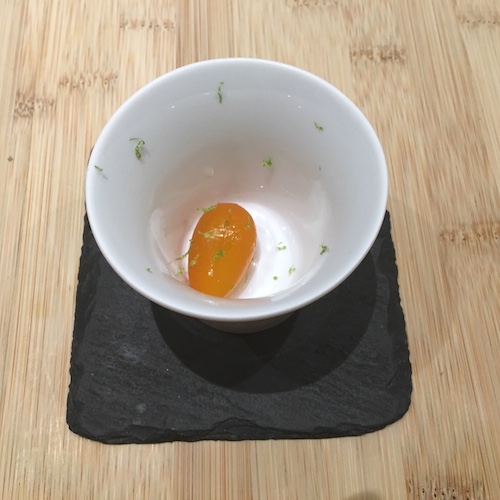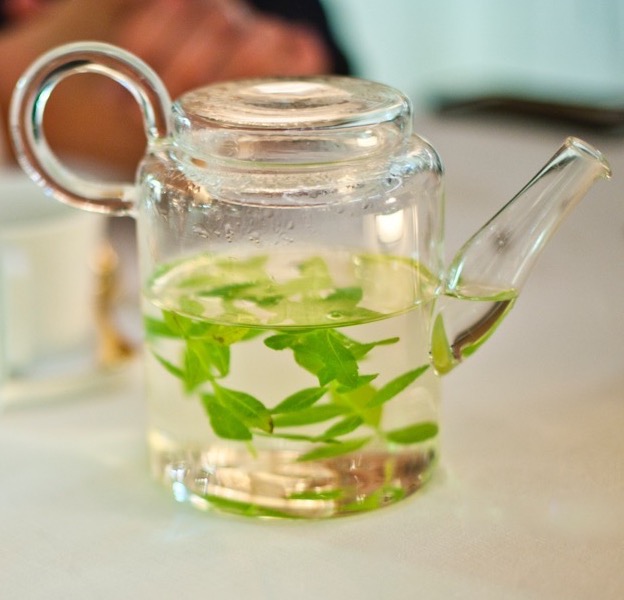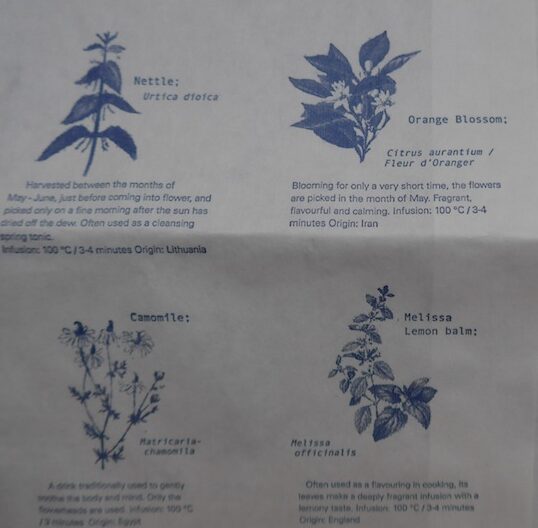Tisanes around the world
I assembled a shortlist of my favorite herbal infusions by continent and in some by country of popularity. Most disseminated around as trade shipped these local traditions over the vast oceans and seas, so will probably find them in your country too. Some include brewed dried or fresh fruits and other parts of plants.

Flowers, roots, leaves, beans, husks, grains all plant parts can be used for infused beverages
In China, the wholesome chrysanthemum flower is beloved with any meal, goji berries sprinkled into a herbal brew, fresh ginger for digestive fire best blended with turmeric and pepper for a sharpen me up anti-inflammatory kick, while gymnostemma and other tonics such as astragalus root keep the qi energy flowing.
Korean ginseng is a well-known stimulant. In New York, Cafe & Ginseng boost your stamina while shopping on the Fifth Avenue. Also lotus and quince are brewed delightfully. White lotus available at Manhattan’s Tea Dealers is an intriguing shift to a non-caffeinated Korean treat.
My favorite plant discovery in Asia the persimmon leaf, the brews from the spring wild (sensai) shoots, greens and flowers next to carefully toasted buckwheat (soba-cha) in Japan. I also enjoy the roasted black soybeans brews sold by the temples in Kyoto, yet known as kuromamecha originates from Hokkaido, and what I love is the no leftovers nature of this whole bean, high in fibre brew, you eat after sipping away the brew. Mugi-cha or Barley tea is not suitable for celiacs yet is a perfectly smooth replacement for coffee also widely available in Italy (known as orzo is much tastier than the more bitter dandelion or chicory). Mu Tea is an excellent macrobiotic herbal blend that is as healthful as tasty. In Tokyo, Kagae sells delightful functional tisanes to balance according to your prescribed natural element. I also found an olive leaf fancy box assembled on a small island of Nagasaki. The taste profile was very mild though and I prefer the oil from this potent tree.


Kumquat fruit infused with citrus zest by a Japanese chef Toyo in Paris entered my favourite summer fruit brews. At the private dining club of Yakumo Saryo in Tokyo my birthday meal was concluded with delightful kumquat and ginkgo infusion. There are almost no limits on what edible parts of any plant can be infused into a tisane. In spring in Japan I savored Hana Wasabi brew. These young stems and flowers of the wasabi plant are often used in pickles or in cooking. Not spicy but very refreshing on the palate.
Beyond lemongrass, pandan leaf iced tea is best lightly sweetened, while blue pea flower coloring the brewing liquid stark violet is very hip across Thailand. Rosella, as hibiscus is more locally known, packed with velvety hued, sharp-mouthed Vitamin C superseded echinacea popular in the West. I prefer the more bread-like Bael fruit for taste.


In Europe, I pick elderflower from the low trees late in spring, from my home herb pot the lemongrass-like verbena blades, spiked with some melissa (often known as lemon balm) for calming fragrance. In the Mediterranean I mindfully pick a few fresh orange blossoms to brew a perfume-laced infusion, but never too much as otherwise there won’t be any oranges if you pick all the flowers! I prefer dried Egyptian camomile (best) in cookies and shortbreads, a s I find it’s body too heavy for my taste. Linden is the national tree of Czechia, and my great grandmother used to brew us wholesome tisane each afternoon. Its flying leaves surprisingly are rarely brewed abroad.
Nettle tastes best cold brewed or in refreshing iced teas great to detox your kidneys and build the blood. My Cup of Tea in London blend it savvily with mint for an extra briskness. In spring I also enjoy fresh or dried bright primrose flowers as fragrant as steeped jasmine. Ever since I spent eight years living in the Mediterranean, rosemary drops into my water on any occasion. Cold or hot brewed, I am transported to the pine-laced coastal hikes I enjoy so much there. Birch bark is more medicinal like its kidney cleansing sap, do not expect delight in its brew. On the other side of beer are the calming hops brewed into a zero-proof evening cup. The Alpine meadows in summer inspire herb pickers into fragrant mountain blends, as diverse as each region. In Greece, Mountain Tea has been revered for millennia.


In South Africa, rooibos is like Chardonnay. Popular for its compatibility with other fragranced spices like vanilla, its flexible quite neutral taste is a winner. Locally known as bush tea, red tea, or redbush tea it grows wildly in rosemary-like clusters. Its high mineral content adds to its appeal.
In the North, the Middle Eastern influences grew the popularity of peppermint and spices sometimes spiked with strong black tea. Spearmint or Jewish mint as the Moroccans often call it is more intensely aromatic and pronounced in the mouth. In Marrakech, I am always smitten by the vast blending possibilities on the spice market. An added myrrh sap hardened into stone-like gum (of the tree Commiphora myrrha) with raw panela hues aromatised my clove, star anise, mint and who knows what African mountain herbs blend as sweet as a cake so ideal when craving sugar after lunch. I also enjoy the cracked, not ground cinnamon bark in those blends, ideal to balance your blood sugar. Perhaps it was the Middle Eastern Islamic avoidance of alcohol that broadened the herbal spectrum of brews to included spices. Mulberry leaf is another wonderful sleep aid, and Persian rose not just flatters the skin, but I can have it in a ny form – be it dried in cookies, infused in tisane, added to gelato or bejewelled rice.


In India, Masala spices perfume not only food but also tea. Herbs have been more used medicinally as in China. Ayurveda, the mother of systemic herbal remedies, preceded the introduction of tea on its soil and culture by the British. Ayurveda dwells in the plant realm for helping unwellness. Neem, holy basil or tulsi expanded to yogic and chakras balancing ‘teas’. Devotion to herbal brews has also a long tradition in Jamaica where hibiscus stars next to its “bush tea” made from a very bitter herb momordica charantia originating in Africa, the Mediterranean and the Middle East, but known as cerasee revered in many tropical countries.

In South America, and mainly in Argentina, Uruguay and Paraguay not just the poor, the gauchos, but now also the wealthy socialites sip on mate through the personal metal straws (the predecessors of today’s popular no-plastic rods) and a hollow calabash gourd ornamented with carvings and lined with metal on its rim. In a 2017 New York Times article Martin Caparros wrote about this “Argentina’s most sacred drink” increasing penetration across the social classes there. “It’s a bitter drink that no one else drinks, a sharing ritual that we don’t share with outsiders.” Indeed, when I sipped on mate while in Argentina it was more about doing the local rather intimate sucking and sharing rather than enjoying its brash taste. Globalisation and the quest for the next big super herb has since then lifted yerba mate into the hippest grocers in the West. Its mystical origin in the trial Guarani allures our palates.
The same exoticism applies to Brazilian hit guarana, another energizing leafy plant added more often in a form of a sweetening sirup into acai bowls, but increasingly also found in a pure dried form on the tisane shelves. Likewise, guayusa stimulates the Brazilians for a better performance, and tastes better according to my palate.
To ease the altitude sickness in the Andes, coca leaf is steeped in Peru without the illegal effects of its transformed extract. When I arrived in Cuzco, I could not stop my weary body from drinking this local savior hopefully. Cacao husks, leftover from the production of chocolate were popularised under the name cascara. Wonderfully infused in sparkling cold brews, they make also a mild companion in lattes (preferably with oat milk). Maracuja leaves are not to be wasted either, try if you can find them beyond Brazil. I like to blend them with dried rose buds.

